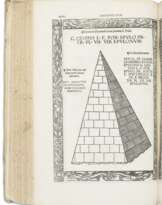ID 627570
Los 80 | Xing Tu, manuscript star map
Schätzwert
$ 30 000 – 50 000
Rare and important Chinese Star map. It depicts the north polar hemisphere constellation map in the upper half, and the south polar counterpart inset below. The four orientations are written in red at the four corners, with the north at the upper left. In China the twelve Jupiter stations were correlated with the twelve ancient States of China, and used to interpret celestial omens. The elaborate texts in the lower half are from Chinese classical literature, introducing astronomical knowledge of the celestial bodies from the perspective of Chinese philosophy and matching the celestial system with the hierarchical social structure on earth. The text also mentions that the maps are modeled on a “Celestial Map” by Ferdinand Verbiest (1623-1688). It probably refers to Chidao Nanbei Xingtu (South and North Polar Constellation Maps Bordered by the Equator) done in 1672, which does not survive. (Golvers) As an assistant of Johann Adam Schall von Bell (1591-1666), Verbiest must have seen his Chidao Nanbei Liang Zongxingtu (Two Overall South and North Polar Constellation Maps Divided by the Equator) produced in 1634 (a copy in the collection of the First Historical Archives of China). Schall von Bell’s map was developed from information in an influential calendrical treatise he edited with Xu Guangqi (1562-1633) during 1629-1635 – Chongzhen Lishu (Chongzhen Calendar), which was revised and republished several times in the Qing dynasty. Its reproduction in 1683 was conducted by Verbiest. (Zhang). Apart from Schall von Bell’s map, another prototype of Verbiest’s map may be the stele with the star map designed by Southern Song cartographer Huang Shang (1146-c.1194), which was reproduced in 1506. All of these star maps and publications reflect the efforts the Jesuits made to introduce Western astronomy to China at the turn of the Ming and Qing dynasties. When the original of the present lot was executed in 1672, Verbiest was already appointed to the position of the “acting Director” of Qintianjian (Astronomical Bureau), and was working on the construction of six astronomical instruments, which are extant in the Beijing Ancient Observatory, and the writing of a manual for the instruments, Lingtai Yixiang Zhi (Notes of the Astronomical Instruments in the Observatory), which lists approximately 1366 stars from the 11th to the 14th volumes. The original of the present lot was probably a study Verbiest did in the course of the astronomical instrument project. The last line of the text on the present lot reads “Compiled with respect according to Verbiest’s map in the fifth month of the fifty-first year during Kangxi’s reign (1712).” Since Verbiest’s map was most likely stored in the Astronomical Bureau, the author of the present lot was probably an official or student working in the Bureau. References: Noël Golvers, “Verbiest , Ferdinand,” Conimbricenses.org Encyclopedia (2019); Zhaoxin Zhang, “Research on the Origin and Circulation of the Star Maps in Xiyang Xin Fali Shu (Chongzhen Calendar),” Journal of Dialectics of Nature, Vol. 30, No. 2 (2008), pp. 74, 81-86.
Manuscript circular star map, ink and color on Chinese paper, old, very pale green silk border, approximately 1310 x 635 mm (image) with silk border to 1390 x 655 mm, modern backing. All texts in Chinese, recording observations and various lunar lodges. The milky way is painted in blue. The equator and some stars in red, and ecliptic in yellow. (Overall soiling and staining, rubbing, tears along the previous folds; a long crack across the upper edge (not affecting the map), a 25 x 40 mm excision and a 90 mm scratch in the area of the text at the lower half part, affecting contents.)
Please note that this lot is subject to an import tariff. If the buyer instructs Christie’s to arrange shipping of the lot to a foreign address, the buyer will not be required to pay the import tariff. If the buyer instructs Christie’s to arrange shipping of the lot to a domestic address, if the buyer collects the property in person, or if the buyer arranges their own shipping (whether domestically or internationally), the buyer will be required to pay the import tariff. Please contact Post Sale Services on +1 212 636 2650 prior to bidding for more information.
| Künstler: | William Shakespeare (1564 - 1616) |
|---|---|
| Angewandte Technik: | Bleistift |
| Künstler: | William Shakespeare (1564 - 1616) |
|---|---|
| Angewandte Technik: | Bleistift |
| Adresse der Versteigerung |
CHRISTIE'S 8 King Street, St. James's SW1Y 6QT London Vereinigtes Königreich | |
|---|---|---|
| Vorschau |
| |
| Telefon | +44 (0)20 7839 9060 | |
| Aufgeld | see on Website | |
| Nutzungsbedingungen | Nutzungsbedingungen |












